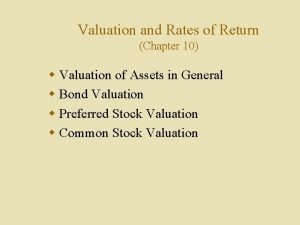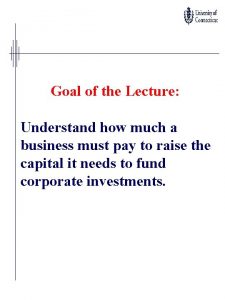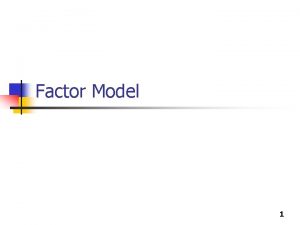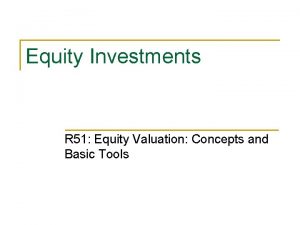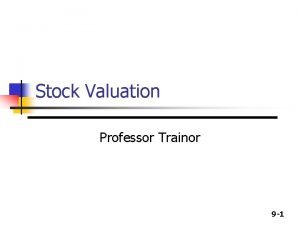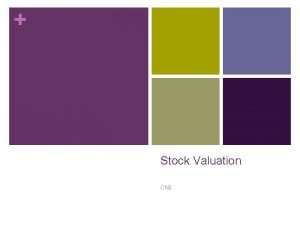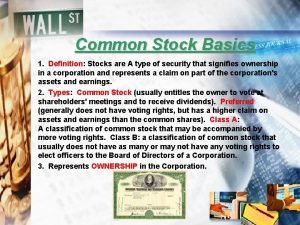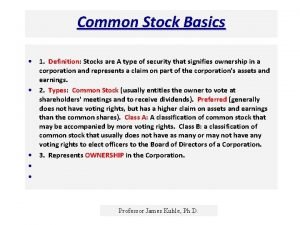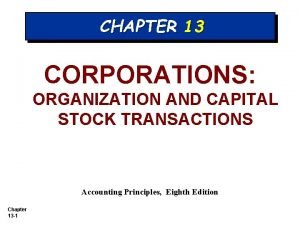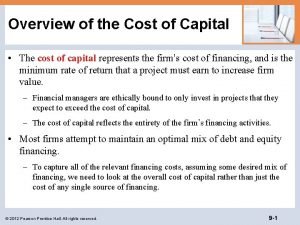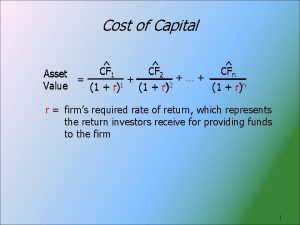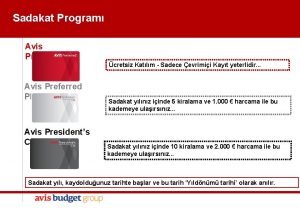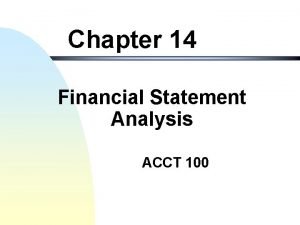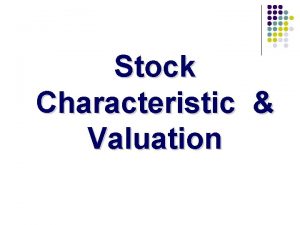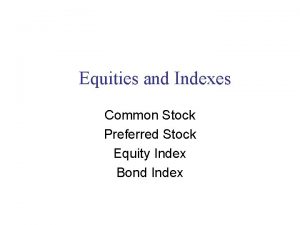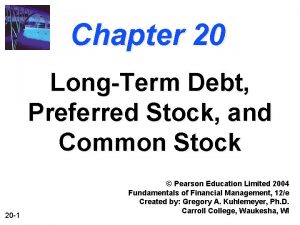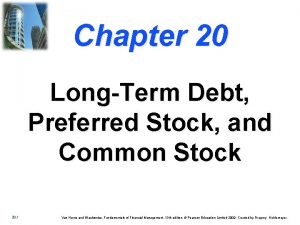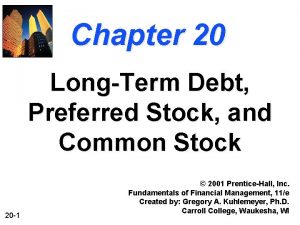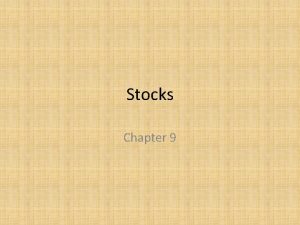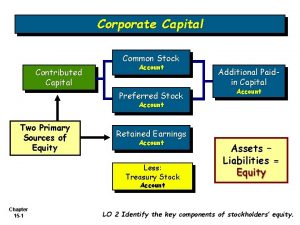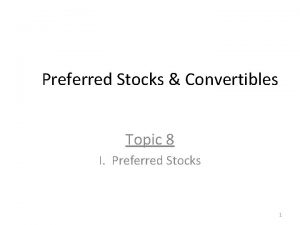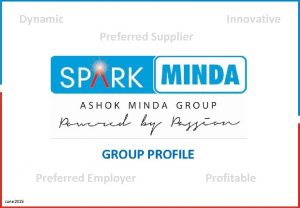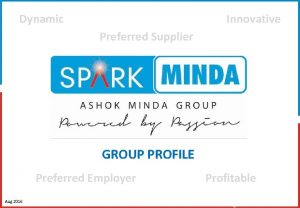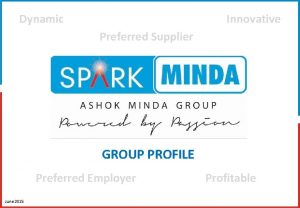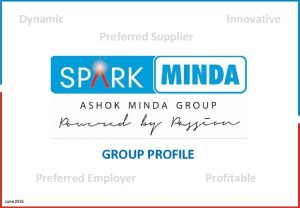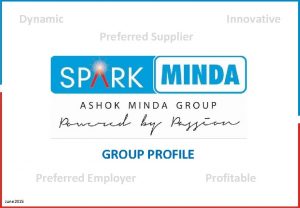Chapter 17 Mc GrawHillIrwin Common and Preferred Stock



































- Slides: 35

Chapter 17 Mc. Graw-Hill/Irwin Common and Preferred Stock Financing Copyright © 2011 by The Mc. Graw-Hill Companies, Inc. All rights reserved.

Chapter Outline • Common stockholders – Rights and privileges • Cumulative voting and its characteristics • Rights offering • Poison pills and other regulatory provisions • Preferred stock 17 -2

Common Stock • Represents the ultimate ownership of a firm • Though stockholders directly control the business, it is practically wielded by management on an everyday basis 17 -3

Preferred Stock • Plays a secondary role in financing the corporate enterprise • Represents a hybrid security by combining some of the features of debt and common stock • Preferred stockholders do not have an ownership interest in the firm • They have a priority to claim dividends over common stockholders 17 -4

Common Stockholders – Rights • Three key rights: – Residual claim to income – Voting right – Right to purchase new shares 17 -5

Common Stockholders’ Claim to Income • Common stockholders have a residual claim to income regardless of payment of dividends or retention by the firm • They do not have a legal or enforceable claim to dividends • A firm may have several classes of common stock outstanding that carry different rights to dividends and income 17 -6

Institutional Ownership of U. S. Companies 17 -7

The Voting Right • Common stockholders have the right to: – Vote in the election of board of directors – Vote on all other major issues – Assign a proxy or “power to cast their ballot” • Companies can have different classes of common stock with unequal voting rights 17 -8

Cumulative Voting • Majority voting – Stockholders owning above 50% of common stock may elect all of the directors • Cumulative voting – Stockholders with less than 50% interest may elect some of the directors 17 -9

Cumulative Voting Process • To determine the number of shares needed to elect a given number of directors under this method of voting: • If the number of minority shares outstanding under cumulative voting is known, the number of directors that can be elected can be determined: 17 -10

The Right to Purchase New Shares • A corporate charter containing preemptive right provision requires: – Holders of common stock must be given the first option to buy new shares • This ensures that management cannot subvert the position of present stockholders • Stockholders may choose to sell their rights, rather than exercise them in the purchase of new shares • A corporate that does not include preemptive right provision can include “rights offering” in its charter 17 -11

The Use of Rights in Financing • Used by many U. S. companies and is popular as fund raising method in Europe • Questions to consider: – How many rights should be necessary to purchase one new share of stock? – What is the monetary value of these rights? 17 -12

Monetary Value of a Right • When a rights offering is announced a stock initially trades “rights-on” – Acquiring a right toward a future purchase of the stock – The value of the right when a stock is trading rights-on is: R = (M 0 – S) ÷ (N + 1) Where: M 0= market value – rights-on; S = subscription price; N = number of rights required to purchase a new share of stock • Ex-rights: Buying shares with no right toward future purchase – The value of the right when a stock is trading at ex-right is: R = (Me – S) ÷ N Where: Me= market value – ex-rights 17 -13

Effect of Rights on Stockholders Position Option 1: • Suppose Stockholder A owns 9 shares before the rights offering and has $30 in cash. His holdings would appear as: • If he receives and exercises 9 rights to buy one new share at $30: 17 -14

Effect of Rights on Stockholders Position (cont’d) Option 2: • Sell rights in the market and stay with his position of owning only nine shares and holding cash. The outcome would be: • If a stockholder neither exercises his rights nor sells the rights, he would be at a loss as the total value of his holdings would come down as shown below: 17 -15

Desirable Features of Rights Offering • The position of the current stockholders is protected in regard to voting rights and claims to earnings • Use of rights offerings gives the firm a built-in market for new security issues • It may also generate more interest in the market than a straight public issue • Stock purchased through a rights offering carries lower margin requirements – Margin requirement is the cash or equity that must be deposited with brokerage house or bank, with a balance fund eligible for borrowing 17 -16

Poison Pills • A rights offering made to existing shareholders of a company – Allows existing shareholders to buy additional shares of the stock at a very low price – Used to avoid a takeover – Makes hostile takeovers very expensive and unattractive 17 -17

American Depository Receipts • Certificates that have a legal claim on an ownership interest in a foreign company’s common stock – Also referred to as American Depository Shares (ADSs) – Allows foreign shares to be traded in the United States much like common stock 17 -18

Advantages of ADRs for the U. S. Investor • Annual reports and financial statements are presented in English according to GAAP • Dividends are paid in dollars and are more easily collected • Considered to be: – More liquid – Less expensive – Easier to trade than buying foreign companies’ stock directly on that firm’s home exchange 17 -19

Drawbacks of ADRs for the U. S. Investor • ADRs are also traded in their own country subjecting investors to currency risk • Infrequent reporting of financial results • Information lag due to the time for translation of reports into English 17 -20

Preferred Stock Financing • An intermediate or hybrid form of security • Lacks the desirable characteristics of debt and common stock – Merely entitled to receive a stipulated dividend – Receive payment of dividends before common stockholders – Rights to annual dividends is not mandatory for corporations 17 -21

Justification for Preferred Stock • May be issued to achieve a balance in capital structure • A means of expanding the capital base without: – Diluting the common stock ownership position – Incurring contractual debt obligations • A drawback is that dividend payments are not tax-deductible 17 -22

Investor Interest • Primary purchasers of preferred stock are corporate investors, insurance companies, and pension funds – Under the tax law, the corporate investor must need to add only 30% of preferred or common dividends received from another corporation, to its taxable income – By contrast, all the interest of bonds are taxable to the recipient except for municipal bond interest 17 -23

Summary of Tax Considerations • Tax considerations for preferred stock work in two opposite directions: – They make the after-tax cost of debt cheaper than preferred stock to the issuing corporation • Interest is deductible to the payer – Tax considerations generally make the receipt of preferred dividends more valuable than bond interest • Since 70% of the dividend is exempt from taxation 17 -24

Provisions Associated with Preferred Stock • The following stipulations and provisions define preferred stockholder’s claim to income and assets – Cumulative dividends – Conversion feature – Call feature – Participation provision – Floating rate – Auction rate preferred stock – Par value 17 -25

Cumulative Dividends • Cumulative preferred stock have a cumulative claim to dividends – If preferred stock dividends are not paid in any one year, they accumulate and must be paid in total before common stockholders can receive dividends – This feature makes a corporation aware of its obligations to preferred stockholders • A financial recapitalization may occur if a financially troubled firm has missed a number of dividend payments – Under this arrangement, preferred stockholders receive new securities in place of the dividend that is unpaid 17 -26

Conversion Feature • Allows a company to convert preferred stock into a specified number of shares of common stock • Allows a company to force conversion from convertible preferred stock into convertible debt – Company can take advantage of falling interest rates, or – Company can prefer to change the preferred dividends into tax-deductible interest payments 17 -27

Call Feature • Allows corporations for the retirement of security before maturity – At some small premium over par, at the discretion of the corporation • A preferred issue carrying a call provision will be accorded a slightly higher yield than a similar issue without this feature 17 -28

Participation Provision • A small percentage of preferred stock issues are participating preferreds – They may participate over and above the quoted yield – If the common stock dividend equals the preferred stock dividend: • The two classes of securities may share equally in additional payouts 17 -29

Floating Rate • Floating rate preferred stocks have dividends adjustable in nature • Dividend is changed based on the current market conditions – Investors can minimize the risk of price changes – Investors can take advantage of tax benefits associated with preferred stock corporate ownership – The price stability makes it equivalent to a safe short-term investment 17 -30

Auction Rate Preferred Stock • Also known as Dutch auction preferred stock – The stock is issued to the bidder willing to accept the lowest yield and then to the next lowest bidder, and so on until all the preferred stock is sold • Long-term in nature, behaves like a short-term security – The auction periods vary for each issue, re-auctioned at a subsequent bidding – This is much like the Treasury bill auction – Allows investors to keep up with the changing interest rates in the short-term market – Allows corporate investors to invest at short-term rates and get tax-benefits as well 17 -31

Par Value • Par value of preferred stock is set at the anticipated market value at the time of the issue – Establishes the amount due to preferred stockholders in the event of liquidation – Determines the base against which the percentage or dollar return on preferred stock is computed 17 -32

Comparing Features of Common, Preferred Stock and Debt • Highest return and risk is associated with common stock • Preferred stock generally pays a lower return – Due to the 70% tax exemption status for corporate purchasers • Increasingly high return requirement on debt, based on: – The presence or absence of security provision – The priority of claims on unsecured debts 17 -33

Features of Alternative Security Issues 17 -34

Risk and Expected Return for Various Security Classes 17 -35
 Long-term debt preferred stock and common stock
Long-term debt preferred stock and common stock Common stock characteristics
Common stock characteristics Weakly preferred vs strictly preferred
Weakly preferred vs strictly preferred Preferred stock formula
Preferred stock formula Formula for preferred stock
Formula for preferred stock Single-factor model
Single-factor model Justified price to earnings
Justified price to earnings Cost of preferred stock
Cost of preferred stock Preferred stock valuation
Preferred stock valuation Teknik pembuatan white stock sesuai dengan standar
Teknik pembuatan white stock sesuai dengan standar Stock initial - stock final
Stock initial - stock final Moving and lifting of the patient
Moving and lifting of the patient Common factors of 18 and 27
Common factors of 18 and 27 Common anode and common cathode
Common anode and common cathode Factor tree for 72
Factor tree for 72 What are the factors for 54
What are the factors for 54 Multiples of 18 and 24
Multiples of 18 and 24 Multiples of 9 and 21
Multiples of 9 and 21 Common stock definition
Common stock definition Common stock definition
Common stock definition James kuhle
James kuhle Issued common stock for cash journal entry
Issued common stock for cash journal entry Cara menghitung rata-rata tertimbang
Cara menghitung rata-rata tertimbang Statement of cash flow indirect method
Statement of cash flow indirect method Cost of common stock
Cost of common stock Dividend growth model formula
Dividend growth model formula Capital cf
Capital cf Avis preferred giriş
Avis preferred giriş Start stop continue examples
Start stop continue examples Where is preferred dividends on financial statements
Where is preferred dividends on financial statements Draping in salon
Draping in salon Shrm preferred provider
Shrm preferred provider Arbonne preferred client
Arbonne preferred client Ifr preferred routes
Ifr preferred routes Preferred priorities for care
Preferred priorities for care Legitimate political behavior
Legitimate political behavior



